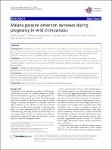Malaria parasite detection increases during pregnancy in wild chimpanzees
Nys, Hélène M. de
Calvignac-Spencer, Sébastien
Boesch, Christophe
Dorny, Pierre
Wittig, Roman M.
Mundry, Roger
Leendertz, Fabian
Background: The diversity of malaria parasites (Plasmodium sp.) infecting chimpanzees (Pan troglodytes) and their close relatedness with those infecting humans is well documented. However, their biology is still largely unexplored and there is a need for baseline epidemiological data. Here, the effect of pregnancy, a well-known risk factor for malaria in humans, on the susceptibility of female chimpanzees to malaria infection was investigated. Methods: A series of 384 faecal samples collected during 40 pregnancies and 36 post-pregnancies from three habituated groups of wild chimpanzees in the Taï National Park, Côte d’Ivoire, were tested. Samples were tested for malaria parasites by polymerase chain reaction (PCR) and sequencing. Data were analysed using a generalized linear mixed model. Results: Probability of malaria parasite detection significantly increased towards the end of pregnancy and decreased with the age of the mother. Conclusions: This study provides evidence that susceptibility to malaria parasite infection increases during pregnancy, and, as shown before, in younger individuals, which points towards similar dynamics of malaria parasite infection in human and chimpanzee populations and raises questions about the effects of such infections on pregnancy outcome and offspring morbidity/mortality.
No license information

